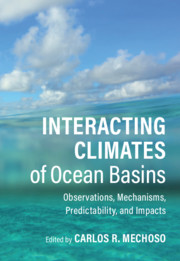Book contents
- Interacting Climates of Ocean Basins
- Interacting Climates of Ocean Basins
- Copyright page
- Contents
- Contributors
- Preface
- 1 Variability of the Oceans
- 2 Teleconnections in the Atmosphere
- 3 Atmosphere–Ocean Interactions
- 4 Interacting Interannual Variability of the Pacific and Atlantic Oceans
- 5 Indian Ocean Variability and Interactions
- 6 The Arctic Mediterranean
- 7 Combined Oceanic Influences on Continental Climates
- 8 Basin Interactions and Predictability
- 9 Climate Change and Impacts on Variability and Interactions
- Index
- References
6 - The Arctic Mediterranean
Published online by Cambridge University Press: 13 January 2021
- Interacting Climates of Ocean Basins
- Interacting Climates of Ocean Basins
- Copyright page
- Contents
- Contributors
- Preface
- 1 Variability of the Oceans
- 2 Teleconnections in the Atmosphere
- 3 Atmosphere–Ocean Interactions
- 4 Interacting Interannual Variability of the Pacific and Atlantic Oceans
- 5 Indian Ocean Variability and Interactions
- 6 The Arctic Mediterranean
- 7 Combined Oceanic Influences on Continental Climates
- 8 Basin Interactions and Predictability
- 9 Climate Change and Impacts on Variability and Interactions
- Index
- References
Summary
The Arctic Mediterranean sits on the “top of the world” and connects the Atlantic and Pacific climate realms via the cold Arctic. It is the combined basin of the Nordic Seas (the Norwegian, Iceland, and Greenland seas) and the Arctic Ocean confined by the Arctic land masses – thus making it a Mediterranean ocean (Figure 6.1; e.g., Aagaard et al., 1985). The Arctic Mediterranean is small for a World Ocean but its heat loss and freshwater uptake is disproportionally large (e.g., Ganachaud and Wunsch, 2000; Eldevik and Nilsen, 2013; Haine et al., 2015). With the combined presence of the Gulf Stream’s northern limb, regional freshwater stratification, and a retreating sea-ice cover, it is likely where water mass contrasts, shifting air-ocean-ice interaction, and climate change are most pronounced in the present world oceans (Stocker et al., 2013; Vihma, 2014).
- Type
- Chapter
- Information
- Interacting Climates of Ocean BasinsObservations, Mechanisms, Predictability, and Impacts, pp. 186 - 215Publisher: Cambridge University PressPrint publication year: 2020
References
- 1
- Cited by



